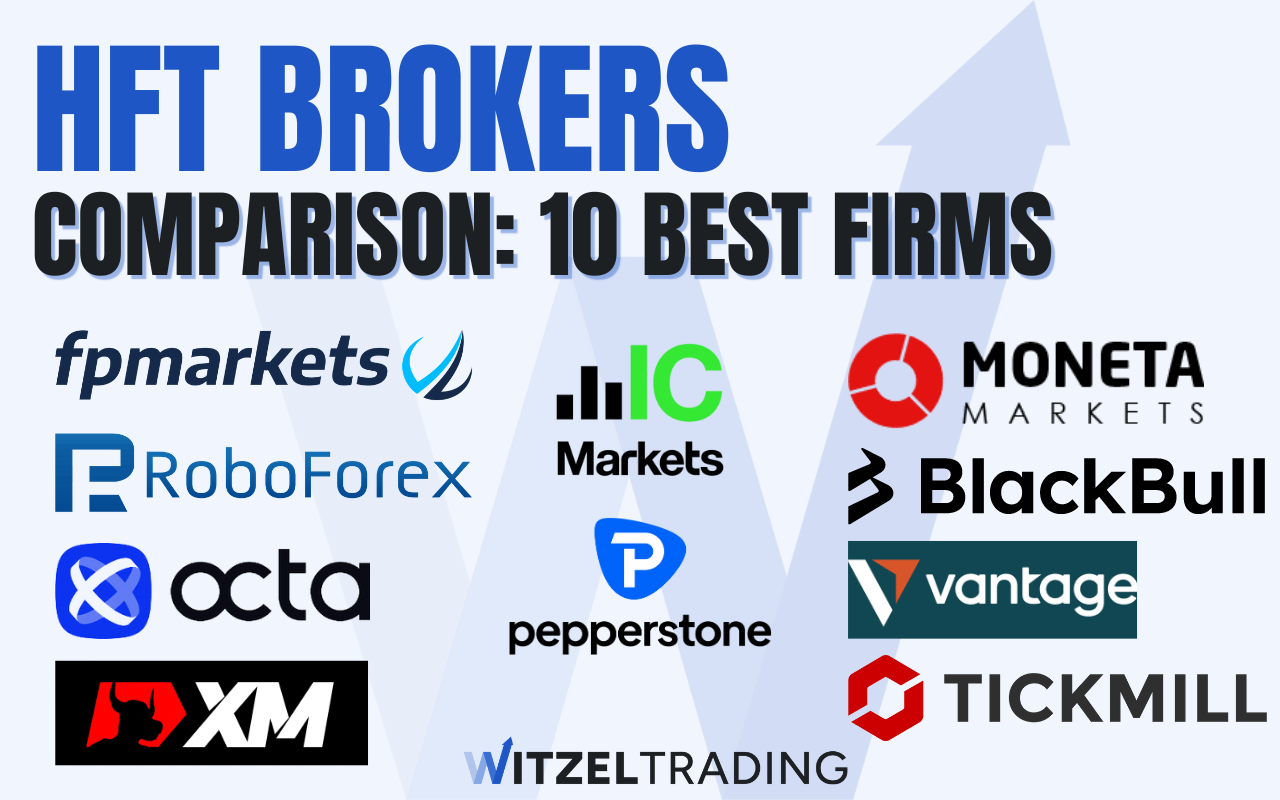Did you know that some algorithms can execute thousands of trades in a single second, making even the fastest human traders look like they're standing still? In this article, we dive deep into the world of High-Frequency Trading (HFT) and its transformative impact on day trading. We’ll explore what HFT is, the cutting-edge technologies that power it, and the advantages and risks it presents for day traders. Learn how algorithms shape HFT strategies, the critical role of data analysis, and the influence of regulations on this fast-paced trading style. We’ll also discuss essential skills for traders, tools needed for success, and how retail traders can compete with HFT firms. Get ready to uncover the future trends in HFT and equip yourself with insights from DayTradingBusiness to excel in this evolving landscape.
What is High-Frequency Trading (HFT) in Day Trading?
High-Frequency Trading (HFT) in day trading involves using advanced algorithms to execute large volumes of trades at extremely high speeds. Traders capitalize on small price discrepancies, often holding positions for mere seconds. The future of HFT is likely to see increased automation, enhanced data analytics, and stricter regulations, which could shape market dynamics and competition. As technology continues to evolve, HFT firms may integrate artificial intelligence to improve decision-making and efficiency.
How is HFT Changing the Day Trading Landscape?
High-frequency trading (HFT) is transforming day trading by increasing market efficiency and liquidity. Traders can execute thousands of orders in milliseconds, leading to tighter spreads and better pricing. This speed advantage means that traditional day traders must adapt by using advanced technology and algorithms to remain competitive. Furthermore, HFT firms often capitalize on short-term market movements, making it harder for individual traders to predict price movements. As a result, day traders are increasingly relying on sophisticated tools, data analytics, and strategies to navigate this fast-paced environment. Overall, HFT is pushing day traders to evolve or risk being left behind.
What Technologies Drive HFT in Day Trading?
High-frequency trading (HFT) in day trading is driven by several key technologies:
1. Algorithmic Trading Software: These programs execute trades based on pre-defined criteria, allowing for rapid decision-making and execution.
2. Low-Latency Networks: High-speed internet connections minimize the delay between order placement and execution, crucial for HFT profitability.
3. Co-location Services: Traders place their servers near exchange data centers to gain faster access to market data and execution.
4. Data Analytics: Advanced analytics process vast amounts of market data to identify trends and trading opportunities in real-time.
5. Machine Learning: Algorithms that adapt and improve based on historical data enhance predictive accuracy for trading strategies.
6. High-Performance Computing: Powerful servers and cloud computing resources handle complex calculations and data processing quickly.
These technologies collectively enhance speed, efficiency, and profitability in high-frequency trading for day traders.
What Are the Advantages of HFT for Day Traders?
High-frequency trading (HFT) offers several advantages for day traders:
1. Speed: HFT algorithms execute trades in milliseconds, capitalizing on price movements faster than human traders.
2. Liquidity: HFT provides increased market liquidity, making it easier for day traders to enter and exit positions without significant price impact.
3. Arbitrage Opportunities: HFT can identify and exploit price discrepancies across different markets, allowing day traders to profit quickly.
4. Lower Transaction Costs: Many HFT firms negotiate lower fees with exchanges due to high trading volumes, which can benefit day traders indirectly.
5. Advanced Technology: Access to sophisticated tools and algorithms enables day traders to analyze market data and execute strategies more effectively.
6. Market Insights: HFT generates large volumes of data, providing day traders with insights into market trends and behaviors.
These factors can enhance profitability and efficiency for day traders leveraging HFT strategies.
What Are the Risks Associated with HFT in Day Trading?
The risks associated with high-frequency trading (HFT) in day trading include market volatility, reduced market liquidity, and technical failures. HFT can exacerbate price swings, leading to unexpected losses. The reliance on algorithms may result in flash crashes if there are glitches. Additionally, competition among firms can lead to decreased profits and increased trading costs. Regulatory scrutiny is another risk, as changes in laws could impact HFT strategies. Lastly, traders may face information overload, leading to poor decision-making.
How Do Algorithms Influence HFT Strategies?
Algorithms are central to high-frequency trading (HFT) strategies by executing trades at lightning speed based on complex mathematical models. They analyze massive datasets to identify patterns and opportunities, allowing traders to capitalize on minute price changes. These algorithms can automatically adjust to market conditions, enhancing decision-making and minimizing risks. As technology advances, machine learning algorithms are increasingly improving predictive accuracy, making HFT strategies more effective. The future of HFT in day trading will likely see greater reliance on sophisticated algorithms that adapt in real-time, ensuring competitive advantages.
What Role Does Data Analysis Play in HFT?

Data analysis is crucial in high-frequency trading (HFT) as it enables traders to identify patterns, make rapid decisions, and execute trades at lightning speed. It involves processing vast amounts of market data to uncover insights that inform trading strategies. Advanced algorithms analyze historical and real-time data, allowing traders to predict price movements and capitalize on minute discrepancies. This data-driven approach enhances efficiency, reduces risks, and improves profitability in day trading, making it a key component for success in the fast-paced HFT environment.
How Will Regulation Impact HFT in Day Trading?
Regulation will likely increase compliance costs for high-frequency trading (HFT) firms, making it harder for smaller players to compete. Stricter rules on market manipulation and transparency can reduce the speed advantage HFT traders currently enjoy. This may lead to reduced liquidity in some markets as HFT firms adjust their strategies. Ultimately, regulation could shift the landscape, favoring established firms with resources to adapt while challenging newer entrants.
What Skills Do Day Traders Need for HFT?
Day traders engaging in high-frequency trading (HFT) need strong analytical skills to interpret market data quickly. Proficiency in programming languages like Python or C++ is essential for developing trading algorithms. They should also understand statistical analysis to identify patterns and trends. Risk management skills are crucial to minimize losses. Familiarity with trading platforms and execution strategies enhances efficiency. Lastly, emotional discipline helps maintain focus under pressure.
How Can Day Traders Leverage HFT Techniques?

Day traders can leverage high-frequency trading (HFT) techniques by utilizing algorithms to execute trades at lightning speed, enabling them to capitalize on small price movements. They can access advanced trading platforms that offer real-time data, allowing for rapid decision-making. Additionally, incorporating strategies like statistical arbitrage and market making can help them identify profitable opportunities quickly. Utilizing co-location services to reduce latency can also enhance their execution speed. Finally, staying informed about market trends and news can help day traders adapt HFT strategies effectively.
Learn about How Do Institutional Traders Use Leverage in Day Trading?
What Are the Common Misconceptions About HFT?
Common misconceptions about high-frequency trading (HFT) in day trading include the belief that HFT is solely responsible for market volatility. In reality, while HFT can impact prices, it also provides liquidity. Another misconception is that HFT is only for large firms; smaller traders can access HFT strategies through advanced platforms. Some think HFT guarantees profits, but it involves significant risks and requires sophisticated technology and algorithms. Lastly, many believe HFT eliminates traditional trading, but it complements it by enhancing market efficiency.
How Do Market Conditions Affect HFT Performance?
Market conditions significantly impact high-frequency trading (HFT) performance. In volatile markets, HFT firms can capitalize on rapid price changes, leading to higher profits. Conversely, in stable markets, profit opportunities diminish as price movements are less pronounced.
Liquidity is also crucial; during low liquidity periods, HFT strategies may struggle due to wider bid-ask spreads and slippage. Additionally, changes in regulations or market structure, like the introduction of transaction fees, can affect HFT profitability. Overall, adapting to market conditions is essential for sustained HFT success in day trading.
Learn about How Market Conditions Affect HFT Strategies
What Are the Future Trends in HFT for Day Traders?
Future trends in high-frequency trading (HFT) for day traders include increased use of artificial intelligence and machine learning for strategy development, enhanced algorithmic trading systems that adapt in real time, and greater reliance on big data analytics for market prediction. Additionally, low-latency trading infrastructure will become even more critical, pushing traders to invest in faster technology. Regulations may also tighten, impacting how day traders operate within HFT environments. Finally, the integration of blockchain technology could reshape trading processes, offering more transparency and efficiency.
How Can Retail Traders Compete with HFT Firms?
Retail traders can compete with high-frequency trading (HFT) firms by focusing on strategies that leverage their strengths. They should develop a solid trading plan based on technical analysis, news events, and market trends rather than speed. Utilizing tools like limit orders can help achieve better prices. Engaging in longer-term trades can reduce the impact of HFT volatility. Additionally, retail traders should stay informed about market developments and use social trading platforms to share insights and strategies. Building a strong psychological mindset and risk management approach is essential for consistent success against HFT firms.
What Tools Are Essential for Successful HFT in Day Trading?
Essential tools for successful high-frequency trading (HFT) in day trading include:
1. Low-Latency Trading Platforms: Speed is crucial; platforms like Interactive Brokers or TradeStation help execute trades rapidly.
2. Direct Market Access (DMA): This allows traders to place orders directly on exchanges, reducing latency.
3. Algorithmic Trading Software: Tools like MetaTrader or NinjaTrader help automate trading strategies.
4. Market Data Feeds: Real-time data from providers like Bloomberg or Thomson Reuters is vital for informed decision-making.
5. Risk Management Software: Solutions like RiskMetrics can help manage exposure and protect against significant losses.
6. Backtesting Tools: Software like QuantConnect allows traders to test strategies against historical data.
7. Execution Management Systems (EMS): Tools to optimize trade execution across various venues.
8. Co-location Services: Positioning servers close to exchange data centers minimizes latency.
Using these tools effectively can enhance performance and profitability in HFT day trading.
How to Choose the Right Brokerage for HFT?

To choose the right brokerage for high-frequency trading (HFT), consider the following factors:
1. Execution Speed: Look for brokers with low latency and fast order execution to maximize your trading efficiency.
2. Commission Rates: Analyze fee structures, ensuring they are competitive for frequent trading to minimize costs.
3. Trading Platform: Select a platform that supports advanced algorithms, real-time data, and necessary APIs for HFT strategies.
4. Market Access: Ensure the brokerage provides access to multiple markets and asset classes to diversify your trading strategy.
5. Regulatory Compliance: Verify the broker’s regulation status to ensure security and reliability in your trading activities.
6. Support and Resources: Choose a brokerage that offers robust customer support and educational resources to assist in optimizing your HFT approach.
7. Reputation and Reviews: Research broker reviews and user feedback to gauge reliability and performance.
Assess these criteria carefully to align with your HFT goals in day trading.
Conclusion about The Future of HFT in Day Trading
As the landscape of day trading evolves, high-frequency trading (HFT) continues to reshape strategies, offering both opportunities and challenges for traders. Understanding the technologies, risks, and skills associated with HFT is essential for success. By staying informed and leveraging effective tools, day traders can navigate this complex environment. For those looking to deepen their knowledge and enhance their trading strategies, DayTradingBusiness provides valuable insights and resources to stay ahead in this competitive field.